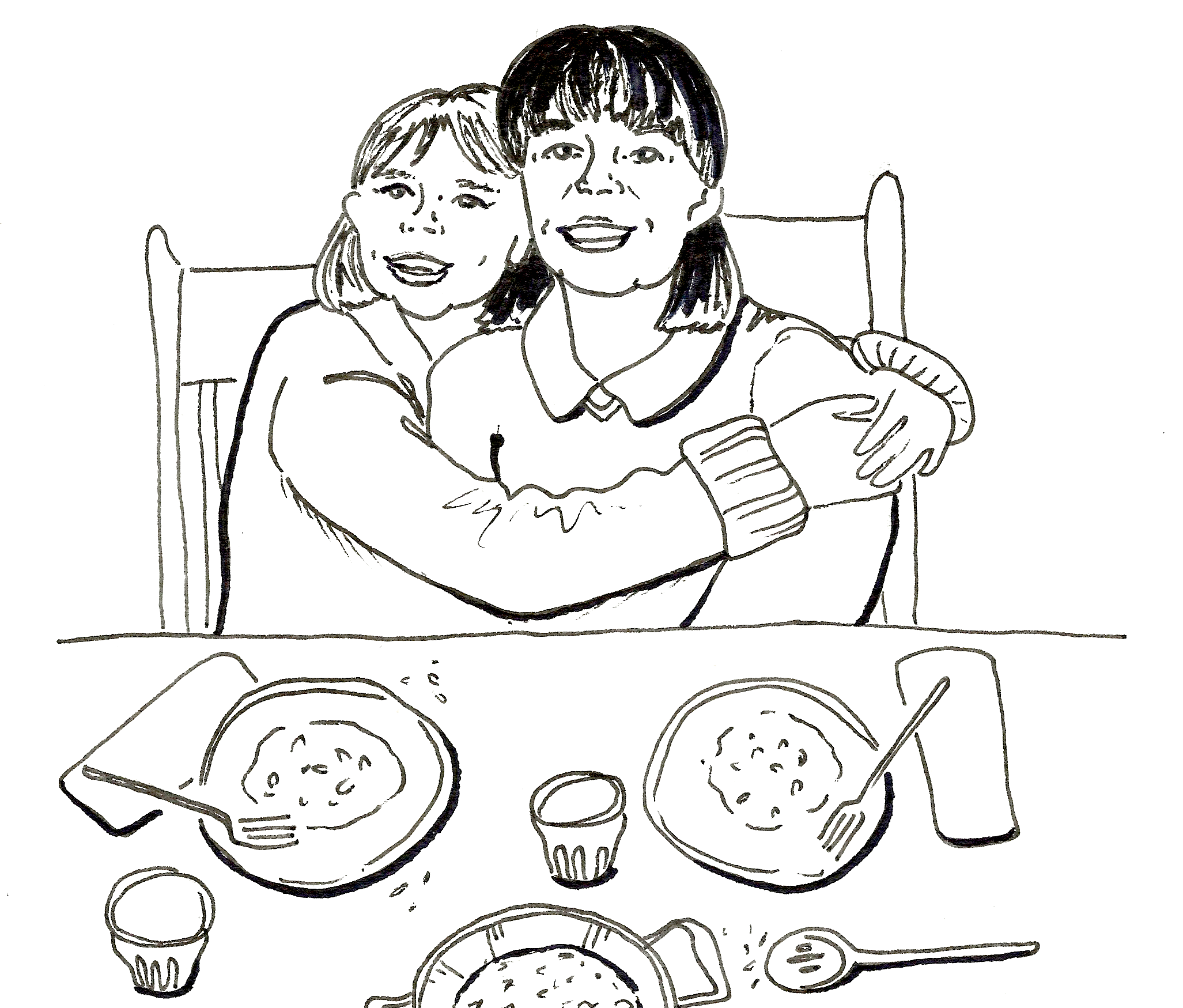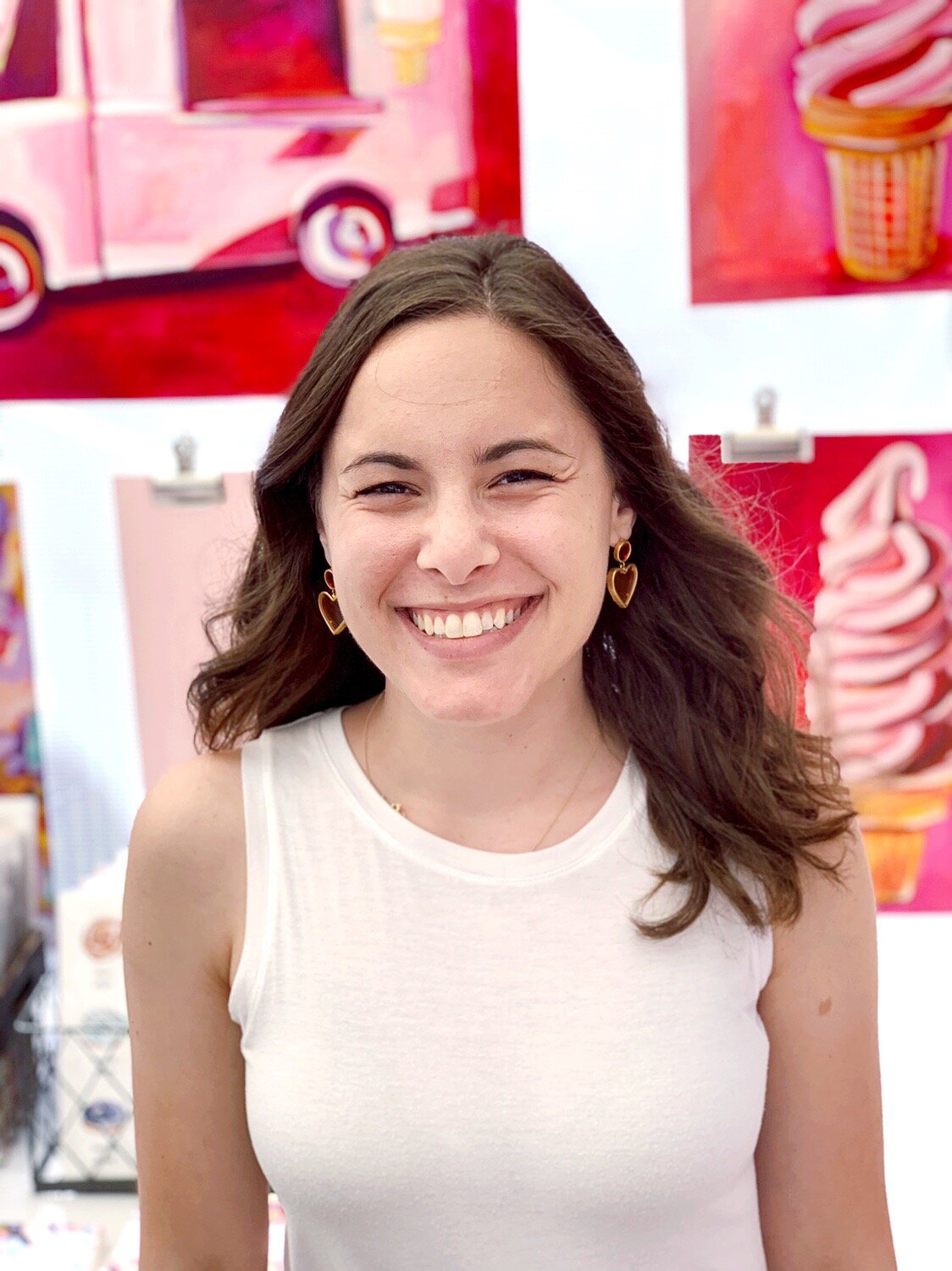Freedom of Eats
Contributor: Rachel DeSimone
Artist: Laurel Greenfield
We sat in the tattoo parlor somewhere too far out on the New Jersey Turnpike, 16-year-old me watching as my 76-year-old nana got a tattoo on her upper arm. On the way there, we had talked about going to get ice cream afterwards, but I wasn’t sure if I’d make it. Sweat beads gathered on my forehead and trickled down my spine because, for one, it was the dead of summer, but mostly because I was excited and nervous that I was next. What used to be an innocent joke about getting matching tattoos suddenly became real.
For us, this seemed natural. She always pushed boundaries to give me what I wanted. From forcing her eyes to stay open to tell me a story at night or giving me an ice cream cone at an unreasonable time of day, my nana never disappointed. I loved opening all of her cupboards to find the cookies and cakes she had stashed away. Growing up in the 1930s, sweets were a scarcity in her house, as her elderly Armenian father had firm beliefs in what foods were healthy and thus acceptable to feed his three girls. As a single, small-business-owning parent raising three girls alone in a low-income, gang-ridden neighborhood in New York City, a strict diet was something he could control.
My great-grandfather first came to the United States from Tarsus, Turkey when he was young. He came here to start a better life for himself after his merchant father was murdered by the Turks and he suffered a bullet straight through his arm. Eager for adventure and to learn a new trade, he moved to America hoping to escape the violence in Turkey against Armenians. He came looking for opportunity, and he found it as a tailor in Hell’s Kitchen. He opened a shop on 10th Avenue in a neighborhood controlled then by the infamous “Westies” Irish mafia. My nana says that she knew it was dangerous, and some of the gang members even lived in her building, but her family members were not involved, so they were left alone. My great-grandfather’s main focus was maintaining his tailor shop and taking care of his girls.
He often prepared richly flavorful Armenian dishes such as okra stew, pilafs, lamb and fish. My nana and her two sisters, Rosie and Sarah, would take turns shopping for the meats at the butcher. She vividly remembers her father, Hagop, making liver and onions with an extensive array of spices; once something she vehemently disliked, now she yearns for.
Her diet today is much different. After years of standing over the stove to feed her own family, these days, she cannot be bothered with cooking. At 86, and twice widowed, she has no desire for structure in her daily diet. She eats what she wants, when she wants—mostly carbs and mostly on an irregular schedule. The family scrutinizes her diet choices, but for her, it is not strange to eat a ham sandwich that she brought home wrapped in a napkin in her purse from the casino several days before.
One thing that hasn’t changed from her childhood is her breakfast—toast and butter, then dipped in cocoa, now dipped in Lipton tea with a splash of milk; her first of many cups a day. Another thing that she has brought with her all these years is her love of rice pilaf, which she has passed down to me. She eats simply now, no fuss involved, which is why this is the dish we always made together as I grew up, and the one I shared in my elementary school cookbook, never once considering any other dish. While the elaborate stews and sarma live on in her memory it’s the humble rice pilaf that has been carried forward onto our plates and is the dish I turn to for comfort.
A “family-filler,” she calls it. It was something that her father would make to accompany the rest of the meal and fill three growing girls, “a basic staple in the meal,” she says, “much like Irish mashed potatoes.” This is the traditional Turkish style of rice pilaf, or pilav, simple with only a handful of ingredients and served as a side dish, not a main. Being from Turkey himself, it’s this one that my great grandfather made time and again. I’ve only ever known it as the star of the meal though. I was so excited to have it each time I did that nothing else on my plate mattered. There was something so special about making this dish with my nana—something that satiated her and helped her grow was now comforting me in a similar way.
I could hear Hagop coming through my nana every time she talked me through making it. As the butter would start to melt in the pot she’d take the nests of vermicelli noodles and break them up in her worn and shaking hands, each small strand landing in the hot butter with a crackle. She always told me to watch them closely because they could burn in a second, and once they did. I would stir the noodles around in the foamy butter with a big metal spoon and then I’d smell it, that caramelly, toasted smell that the noodles and butter created together as the noodles turned from yellow to brown. We’d then add the rice and the rest of the ingredients and I’d wait impatiently for the water to be absorbed and the grains of rice to split open so that I could dive in. I had to wait 10 brutal minutes for the rice to settle once the water was absorbed. My nana warned me each time not to lift the pot’s cover and let out the steam just as her father had; almost every time, I did it anyway, taking a peek inside and getting a little whiff of what was to come. We’d sit together and eat and I could see her travel back in time to when it was her father and her at the table. A grounding that only comes from a dish cooked by someone you love.
The oldest known record of the active use of the word “pilaf” is the ancient Persian word “pilāv,” referring to a dish where whole grains are boiled in broth. Rice was used in the most common version of this. The Turks used the same word, “pilav,” for similar dishes, which makes sense since they were conquered by the Persians of Cyrus around 500 BC and it’s believed that rice pilaf has its origin in Persia. Other variations on rice pilaf included lamb, venison, pistachios, herbs, whole spices or dried fruits, and other cultures have their own adaptations. But I have only ever had my great-grandfather’s traditional Armenian version, which is a simple side dish, and a symbol of his dedication to providing for his girls and raising them with healthy, hearty meals.
My nana was envious of the other kids around her who got to eat junk chocolates and candy regularly growing up. She couldn’t see then the luxury of enjoying the meals of her Armenian heritage made by her father. All she could focus on was the desire to eat like the “American kids,” who were really Irish kids: She wanted meat and potatoes, with just a little bit of vegetables covering her plate. But once a year, during the holidays, the day would come where her father would make a large baking tray of baklava. She went back for piece after piece, claiming it was the best baklava in the entire world.
Today she often rips open a plastic bag to eat a pre-mixed salad for dinner, or grabs a muffin to substitute lunch, craving her father’s cooking all the while. Her free-wielding spirit has flown away from the restriction she once faced, but nostalgia creeps in. She said she always wanted to be a bird so she could fly away. As we admired the birds freshly tattooed on our bodies, I have coffee ice cream and she had butter pecan.
Rachel DeSimone
Rachel is a Boston-based food writer and yoga teacher who craves a good story and a good chocolate chip cookie—the kind that’s just slightly crisp on the edges but soft and gooey in the middle with flat shards of dark chocolate layered throughout. She has an MLA in gastronomy from Boston University and is a storyteller through and through. She gains inspiration from the food memories that have brought her to the place she is today and she is always looking for a way to revisit and honor that which she is nostalgic for through her writing.
Laurel Greenfield
Laurel Greenfield is a Boston-based artist obsessed with capturing nostalgic food memories in vivid color. Laurel received her master’s degree in Gastronomy from Boston University where she studied how deeply rooted food is in our cultural and individual identities. Food has always factored heavily in her favorite memories of time spent with her family and painting is the perfect way to hold on to what would otherwise be fleeting moments. She sells her vibrantly colored prints and paintings from her Boston studio and helps collectors capture their own food memories with commissioned paintings.







